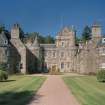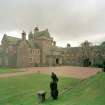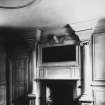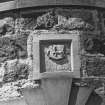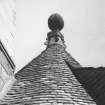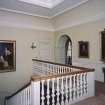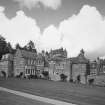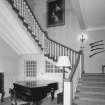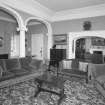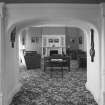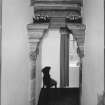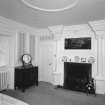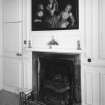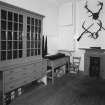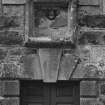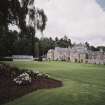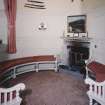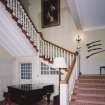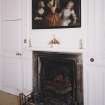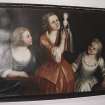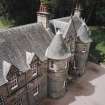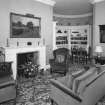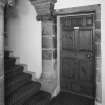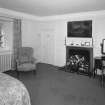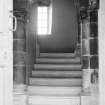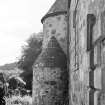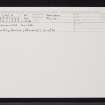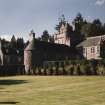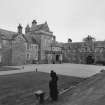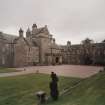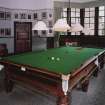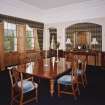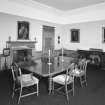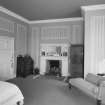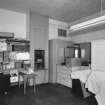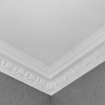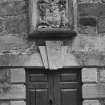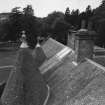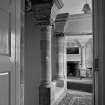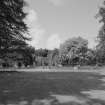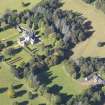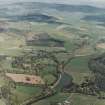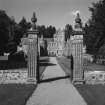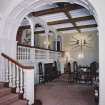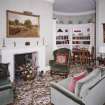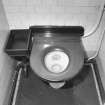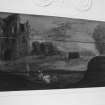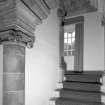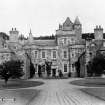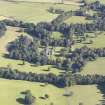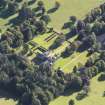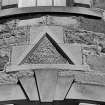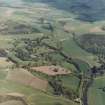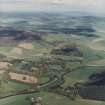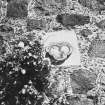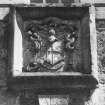Pricing Change
New pricing for orders of material from this site will come into place shortly. Charges for supply of digital images, digitisation on demand, prints and licensing will be altered.
Glenkindie House
Castle (Medieval), Country House (Period Unassigned)
Site Name Glenkindie House
Classification Castle (Medieval), Country House (Period Unassigned)
Alternative Name(s) Glenkindie House Policies; Glenkindy
Canmore ID 17147
Site Number NJ41SW 16
NGR NJ 42269 14452
Datum OSGB36 - NGR
Permalink http://canmore.org.uk/site/17147
First 100 images shown. See the Collections panel (below) for a link to all digital images.
- Council Aberdeenshire
- Parish Towie
- Former Region Grampian
- Former District Gordon
- Former County Aberdeenshire
Glenkindie House, from 16th century. 'A snug château, amidst ancestral trees, and partly clad with ivy' (Jervise). A confection of towers of different dates. U-plan, open to the south, the oldest surviving part is the east wing, two storeys and attic, probably 16th century recast in 1741 - judging by date on door. Quoined surrounds to windows and an
elaborate scale-and-platt stone stair with squat Ionic columns inside. The balancing west wing may date from 1787 or earlier. The north wing, which comprises the present main house, is 1900, by Sydney Mitchell, a two-storey house with nicely off-centre three-storey and caphouse tower oversailing all. Also fine gable with oriels, similar to those of the hall at
Mitchell's Well Court in Edinburgh. This replaced the central house of 1785 which in turn had been built over the site of the house built in 1595 and destroyed in 1644. Dr Douglas Simpson postulated a frontal range with gatehouse like Tolquhon.
Taken from "Aberdeenshire: Donside and Strathbogie - An Illustrated Architectural Guide", by Ian Shepherd, 2006. Published by the Rutland Press http://www.rias.org.uk
NJ41SW 16.00 42269 14452
NJ41SW 16.01 NJ 42220 14297 Dovecot
NJ41SW 16.02 NJ 42712 14258 East Gates
NJ41SW 16.03 NJ 41814 14169 West Gates
NJ41SW 16.04 NJ 42305 14373 Garden walls and gates
NJ41SW 16.05 NJ 42279 14436 Forecourt, sundial
NJ41SW 16.06 NJ 42329 14422 East garden, sundial
NJ41SW 16.07 NJ 4245 1455 Steading
NJ41SW 16.08 NJ 4267 1438 Brow Cottage
NJ41SW 16.09 NJ 4186 1415 West Lodge (Bridgend)
For souterrain (NJ 4191 1433), dun (NJ 4167 1442), standing stone (NJ 4383 1374) and querns (NJ 4360 1424) within Glenkindy House policies, see NJ41SW 2, NJ41SW 6, NJ41SW 9, NJ41SW 12 respectively. For Mill of Glenkindie (NJ 4287 1447), see NJ41SW 43.00. For quernstone found near the West Lodge (NJ c. 418 241), see NJ41SW 214.
The neat villa of Glenkindy is near where the castle of the same name stood, erected by William Strachan in 1595. Several stones in the present villa bear the name and initials of the builder, and the date 1595. It was plundered by Donald Farquherson of Monaltrie in 1639 and demolished in 1644.
A Laing 1828.
The present Glenkindie House is U-plan with courtyard open to the S. The N side of the court, built in 1900, probably occupies the site of the house built in 1595 and destroyed in 1644. The surviving E and W wings are probably of the same 16th century date, but they have been modernised. The E wing bears the date 1741, and the W 1787.
The dovecot in the grounds is a rectangular, rubble-built structure of 17th century date, with double string-course and crow-stepped gables.
SDD 1960- ; Information from unpublished Mss by W D Simpson.
NJ 4227 1443. Glenkindie House, is as described by the Scottish Development Dept. The dovecot (NJ41SW 16.01) at NJ 4221 1429 is complete and in excellent condition.
Visited by OS (NKB) 9 October 1968.
The present house is U-shaped with the courtyard open to the S; the surviving E and W wings are probably of 16th century date but have been modernised. There are conical roofed towers on the SW and SE, and the N part of the house was built in 1900. A 2- and 3-storey building with a cape-house in the manner ofg Sydney Mitchell replaced a plain 2-storey, 3-window central portion of 1785.
There are also: a baluster table dial sundial (dated 1892) in the forecourt; an extensive formal 18th century walled garden with coped sections of 17th century and earlier date; fluted gate piers with the original mid 18th cent ironwork; and a sundial with Doric column table dial dated 1722.
The original houses was built in 1595 and destroyed in 1644. The E and W wings date from 1741 and 1887 respectively, and the later house was built in 1900.
NMRS, MS/712/46.
EXTERNAL REFERENCE:
N.L.S. Miscellany of the 3rd Spalding Club 1940 - photograph












































































































